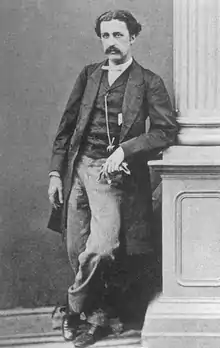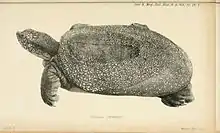Robert Swinhoe
Robert Swinhoe (* 1. September 1836 in Kolkata; † 28. Oktober 1877 in London) war ein britischer Naturforscher, Ornithologe und Zoologe. Sein offizielles botanisches Autorenkürzel lautet „Swinhoe“.

Leben
Swinhoe war der Bruder von Charles Swinhoe, einem Gründungsmitglied der Bombay Natural History Society.
Er wurde in Kolkata (Indien) geboren, studierte an der University of London und trat 1854 dem konsularischen Korps in China bei. In seiner freien Zeit in China sammelte er naturhistorische Proben, und da viele der von ihm besuchten Gebiete noch nie zuvor für abendländische Forscher zugänglich waren, waren viele der von ihm gesammelten Arten neu für die Wissenschaft. Wegen seines Schwerpunktes als Ornithologe waren viele seiner entdeckten Arten Vögel, aber auch Fische, Insekten und Säugetiere wurden gesammelt. 1862 kehrte er mit seinen Sammlungen nach England zurück. Viele der von ihm entdeckten Vögel führte John Gould in seinem Werk Birds of Asia (1863) auf.
Zahlreiche Vögel und andere Tiere wurden nach Swinhoe benannt, so beispielsweise der Swinhoewellenläufer (Oceanodroma monorhis), den er selbst 1867 erstmals beschrieben hatte.
Dedikationsnamen

John Gould widmete ihm 1863 den Namen des Swinhoefasans (Lophura swinhoii).[1] Armand David benannte 1874 den Grauflankensäbler (Pomatorhinus swinhoei) zu seinen Ehren.[2] John Edward Gray benannte 1862 die Taiwan-Serau (Capricornis swinhoei)[3], Alphonse Milne-Edwards 1874 das Swinhoe-Streifenhörnchen (Tamiops swinhoei)[4] nach ihm. George Albert Boulenger benannte 1903 die Echten Frosch-Art Odorrana swinhoana nach ihm.[5] Mit Diploderma swinhonis[6] und Gekko swinhonis[7] bedachte ihn Albert Günther 1864 sowie mit Rhabdophis swinhonis[8] im Jahr 1868 gleich in drei Arten. Bei der Jangtse-Riesenweichschildkröte (Rafetus swinhoei)[9], die John Edward Gray 1873 beschrieb, verstarb das letzte bekannte Weibchen am 13. April 2019.
Außerdem findet sich sein Name in der Azurelster-Unterart (Cyanopica cyanus swinhoei Hartert, E, 1903),[10] der Grauscheitelspecht-Unterart (Yungipicus canicapillus swinhoei (Hartert, E, 1910)),[11] der Goldgrasmücken-Unterart (Lioparus chrysotis swinhoii (Verreaux, J, 1871)),[12] der Spitzschwanz-Bronzemännchen-Unterart (Lonchura striata swinhoei (Cabanis, 1882))[13], der Fleckenhals-Buschtimalie-Unterart (Stachyris strialata swinhoei Rothschild, 1903)[14] und der Sambar-Unterart (Cervus unicolor swinhoii Sclater, PL, 1862)[15].
Mecistura swinhoei Pelzeln, 1867[16] wird heute als Synonym zur Silberkehl-Schwanzmeise (Aegithalos glaucogularis (Gould, 1855)), Bubo bubo swinhoei Hartert, E, 1913[17] als Synonym für die Uhu-Unterart (Bubo bubo kiautschensis Reichenow, 1903), Hydrochelidon leucopareia swinhœi Mathews, 1912[18] als Synonym für die Weißbart-Seeschwalbe (Chlidonias hybrida (Pallas, 1811)), Cuculus Swinhoei Cabanis & Heine, 1863[19] als Synonym für den Kurzflügelkuckuck (Cuculus micropterus (Gould), 1838), Merops Swinhoei Hume, 1873[20] als Synonym für den Braunkopfspint (Merops leschenaulti Vieillot, 1817), Platalea Swinhoei Stejneger, 1887[21] als Synonym für den Schwarzgesichtlöffler (Platalea minor Temminck & Schlegel, 1849) und Oriolus chinensis swinhoii Momiyama & Isii, 1928[22] als Synonym für die Schwarznackenpirol-Unterart (Oriolus chinensis diffusus Sharpe, 1877) betrachtet.
Nicht ihm, sondern seinem Bruder ist die Sundevall-Rennratten-Unterart (Meriones crassus swinhoei (Scully, 1881)) gewidmet.[23]
Publikationen (Auswahl)
- On new and little-known birds from China. In: Proceedings of the Scientific Meetings of the Zoological Society of London for the Year 1863. 1863, S. 87–94 (biodiversitylibrary.org).
- A list of the Formosan reptiles; with notes on a few of the species, and some remarks on a fish (Orthagoriscus, sp.). In: The Annals and magazine of natural history; zoology, botany, and geology (= 3). Band 12, Nr. 69, 1864, S. 219–226 (biodiversitylibrary.org – 1863).
- Ornithological Notes from Formosa. In: The Ibis (= New Series). Band 2, Nr. 14, 1866, S. 292–406 (biodiversitylibrary.org).
- Jottings on Birds from my Amoy Journal. In: The Ibis (= New Series). Band 3, Nr. 10, 1867, S. 226–237 (biodiversitylibrary.org).
- Jottings on Birds from my Amoy Journal. In: The Ibis (= New Series). Band 3, Nr. 12, 1867, S. 385–413 (biodiversitylibrary.org).
- A Revised Catalogue of the Birds of China and its Islands, with Description of New Species, References to former Notes, and occasional Remarks. In: Proceedings of the Scientific Meetings of the Zoological Society of London. 1871, S. 337–423 (biodiversitylibrary.org).
- Descriptions of two new Pheasants and a new Garrulax from Ningpo, China. In: Proceedings of the Scientific Meetings of the Zoological Society of London for the Year 1872. 1872, S. 550–554 (biodiversitylibrary.org).
Literatur
- Anonym: Robert Swinhoe F.R.S. In: Nature a weekly illustrated Journal of Science. Band 17, 8. November 1878, S. 35 (biodiversitylibrary.org).
- Anonym: Robert Swinhoe. In: Journal of botany, British and foreign. Band 16, 1878, S. 96 (biodiversitylibrary.org).
- George Albert Boulenger: Descriptions of new batrachians in the British Museum. In: The Annals and magazine of natural history; zoology, botany, and geology (= 7). Band 12, Nr. 71, 1903, S. 552–557 (biodiversitylibrary.org).
- Jean Louis Cabanis, Ferdinand Heine junior: Museum Heineanum Verzeichniss der ornithologischen Sammlung des Oberamtmann Ferdinand Heine auf Gut St. Burchard vor Halberstadt. Mit kritischen Anmerkungen und Beschreibung der neuen Arten systematisch bearbeitet von Jean Cabanis, erstem Custos der Königlichen zoologischen Sammlung zu Berlin und Ferdinand Heine, Stud. philos. In: IV. Theil, die Klettervögel Kuckuke und Faulvögel. Band 4, Nr. 1. In Commission der Frantz'schen Buchhandlung (G. Loose), Halberstadt 1863 (biodiversitylibrary.org – 1862-1863).
- Jean Louis Cabanis: Herr Cabanis spricht über einen solchen Vogel aus China als Uroloncha Swinhoei n. sp. In: Journal für Ornithologie (= 4). Band 30, Nr. 4, 1882, S. 462–463 (biodiversitylibrary.org).
- Armand David: Description de quelques oiseaux de chine. In: Annales des sciences naturelles Zoologie (= 5). Band 19, Nr. 14, 1874, S. 1–5 (biodiversitylibrary.org).
- John Gould: Descriptions of Sixteen New Species of Birds from the Island of Formosa, collected by Robert Swinhoe, Esq., Her Majesty's Vice-Consul at Formosa. In: Proceedings of the Scientific Meetings of the Zoological Society of London for the Year 1862. 1863, S. 280–286 (biodiversitylibrary.org – 1862).
- John Edward Gray: Notice of a new "wild goat" (Capricornis swinhoei) from the Island of Formosa. In: The Annals and magazine of natural history; zoology, botany, and geology (= 3). Band 10, Nr. 58, 1862, S. 320 (biodiversitylibrary.org).
- John Edward Gray: Notes on Chinese mud-tortoises (Trionychidae), with the description of a new species sent to the British Museum by Mr. Swinhoe, and observations on the male organ of this family. In: The Annals and magazine of natural history; zoology, botany, and geology (= 4). Band 12, Nr. 68, 1873, S. 156–161 (biodiversitylibrary.org).
- Albert Günther: The reptiles of British India. Published for the Ray Society by Robert Hardwicke, London 1864 (biodiversitylibrary.org).
- Albert Günther: Sixth account of new species of snakes in the collection of the British Museum. In: The Annals and magazine of natural history; zoology, botany, and geology (= 4). Band 1, Nr. 6, 1868, S. 413–428 (biodiversitylibrary.org).
- Ernst Hartert: Die Vögel der paläarktischen Fauna systematische Übersicht der in Europa, Nord-Asien und der Mittelmeerregion vorkommenden Vögel. Band 1. R. Friedländer & Sohn, Berlin 1903 (biodiversitylibrary.org).
- Ernst Hartert: Die Vögel der paläarktischen Fauna systematische Übersicht der in Europa, Nord-Asien und der Mittelmeerregion vorkommenden Vögel. Band 2. R. Friedländer & Sohn, Berlin 1913 (biodiversitylibrary.org – 1912-1921).
- Ernst Hartert: The birds of Hainan. In: Novitates zoologicae: a journal of zoology in connection with the Tring Museum. Band 17, Nr. 1, 1910, S. 189–254 (biodiversitylibrary.org).
- Allan Octavian Hume: Nests and Eggs of Indian Birds (Rough Draft). Nr. 1. Office of Superintendent of Government Printing, Kalkutta 1873 (books.google.de – 1873-1875).
- Gregory Mathews: The Birds of Australia. Band 2. Witherby & Co., London 1912 (englisch, biodiversitylibrary.org – 1912-1913).
- Henri Milne Edwards, Alphonse Milne-Edwards: Recherches pour servir à l'histoire naturelle des mammifères comprenant des considérations sur la classification de ces animaux. Band 1. G. Masson, Paris 1874 (biodiversitylibrary.org – 1868-1874).
- Toku Taro Momiyama, Terukichi Isii & Fumiko Takizawa: A list of the birds collected by Mr. S. Maki in Formosa, preserved in the Zoological Institute, College of Science, Kyoto Imperial University. In: Annotationes ornithologiae orientalis. Toa chogaku iho. Band 1, Nr. 2, 1928, S. 149–170.
- August von Pelzeln in Bernhard von Wüllerstorf-Urbair: Vögel in Reise der österreichischen Fregatte Novara um die Erde in den Jahren 1857, 1858, 1859 unter den Befehlen des Commodore B. von Wüllerstorf-Urbair (= Zoologischer Theil. Wirbelthiere (Säugethiere, Vögel), Nr. 1). Aus der kaiserlich-königlichen Hof- und Staatsdruckerei, Wien 1867 (biodiversitylibrary.org).
- Walter Rothschild, 2. Baron Rothschild: Mr. Rothschild also made remarks on a large collection of birds received from the Island of Hainan. In: Bulletin of the British Ornithologists' Club. Band 14, Nr. 100, 1903, S. 6–9 (biodiversitylibrary.org).
- Osbert Salvin, Philip Lutley Sclater: Obituary of the late R. Swinhoe, F.R.S. In: The Ibis (= 4). Band 2, Nr. 5, 1878, S. 126–128 (biodiversitylibrary.org).
- Philip Lutley Sclater: Note on the Deer of Formosa. In: Proceedings of the Scientific Meetings of the Zoological Society of London for the Year 1862. 1862, S. 150–152 (biodiversitylibrary.org).
- John Scully: On some mammals from Kandahar. In: The Annals and magazine of natural history; zoology, botany, and geology (= 8). Band 5, Nr. 45, 1881, S. 222–229 (biodiversitylibrary.org).
- Leonhard Hess Stejneger: Review of Japanese birds. V.. Ibises, Storks, and Herons. In: Proceedings of the United States National Museum. Band 10, 1887, S. 271–319 (biodiversitylibrary.org – 1888).
- Jules Verreaux: Description des oiseaux nouveaux ou incomplètement connus collectés par M. l’Abbe Armand David pendant son voayage dans le Thibet Oriental et la partie adjacente de la Chine. In: Nouvelles archives du Muséum d’histoire naturelle. Band 7, 1871, S. 25–66 (biodiversitylibrary.org).
Weblinks
- Autoreintrag und Liste der beschriebenen Pflanzennamen für Robert Swinhoe beim IPNI
Einzelnachweise
- John Gould (1863), S. 284.
- Armand David (1874), S. 5.
- John Edward Gray (1862), S. 320.
- Alphonse Milne-Edwards in Henri Milne Edwards u. a. (1874), S. 320.
- George Albert Boulenger (1903), S. 556.
- Albert Günther (1864), S. 133.
- Albert Günther (1864), S. 104.
- Albert Günther (1868), S. 420.
- John Edward Gray (1873), S. 157 & Tafel V.
- Ernst Hartert (1903), S. 24.
- Ernst Hartert (1910), S. 221.
- Jules Verreaux (1871), S. 38.
- Jean Louis Cabanis (1882), S. 462.
- Walter Rothschild, 2. Baron Rothschild (1903), S. 8.
- Philip Lutley Sclater (1862), S. 152 & Tafel 17.
- August von Pelzeln (1867), S. 66, Tafel 3 Abbildung 1.
- Ernst Hartert (1913), S. 966.
- Gregory Mathews (1912), S. 320.
- Jean Louis Cabanis u. a. (1863), S. 37.
- Allan Octavian Hume (1873), S. 102.
- Leonhard Hess Stejneger (1887), S. 284.
- Toku Taro Momiyama & Terukichi Isii in Toku Taro Momiyama, Terukichi Isii & Fumiko Takizawa (1928), S. 156.
- John Scully (1881), S. 229.